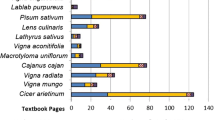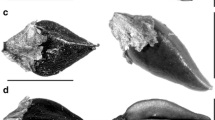Abstract
Plant domestication is a complex process in which natural and cultural factors play important roles delimiting evolutionary pathways of plants under cultivation. In order to deal with and understand the changes generated during this process, multi-disciplinary research is required, especially when a full picture of the domestication history of a taxon is to be assessed. We present here some advances in the study of Cucurbita maxima (squash) domestication from an integrated perspective, including experimental, morphometric and archaeobotanical approaches, which are discussed in the light of new data from physiological analyses. Modern material includes plants obtained from experimental fields, derived from crosses between domesticated (C. maxima ssp. maxima) and spontaneous/wild forms (C. maxima ssp. andreana), resulting in F1 and F2 generations. The archaeobotanical material includes remains recovered from sites in southern Peru and northwest Argentina ranging in date from 3,000 to 800 bp. Morphological and anatomical analyses were conducted on seeds, pericarps and peduncles (the stem of the flower or fruit) for reconstructing squash size and shape evolution under domestication. The results suggest the presence of hybrid forms, mainly from the earlier sites, but also from more recent ones. As expected, a linear evolutionary pathway was not found. Diversity and multiple crossings seem to have been a constant in squash cultivation over time, emphasising the role of gene flows between domestic and wild variants in the domestication process. Finally, we hypothesize the possible linkage between past gene flow and different dormancy patterns as part of management practices, allowing the maintenance of squash populations adapted to different environmental conditions.









Similar content being viewed by others

References
Aguirre-Dugua X, González-Rodríguez A (2016) Phylogeographical approaches to the study of plant domestication, with special emphasis on perennial plants. In: Lira R, Casas A, Blancas J (eds) Ethnobotany of Mexico. Springer, New York, pp 319–366
Allaby R, Kitchen J, Fuller D (2016) Surprisingly low limits of selection in plant domestication. Evol Bioinform 11(S2):41–51
Ashworth L (1997) Estudios sobre la biología reproductiva del zapallo amargo (Cucurbita andreana, Cucurbitaceae). Dissertation, Universidad Nacional de Córdoba, Argentina
Casas A, Blancas J, Otero-Arnaiz A et al (2016) Evolutionary ethnobotanical studies of incipient domestication of plants in Mesoamerica. In: Lira R, Casas A, Blancas J (eds) Ethnobotany of Mexico. Springer, New York, pp 257–286
Corruccini RS (1995) Of ratios and rationality. Am J Phys Anthropol 96:189–191
Cowan C (1997) Evolutionary changes associated with the domestication of Cucurbita pepo. In: Gremillion K (ed) People, plants and landscapes: Studies in paleoethnobotany. University of Alabama Press, Tuscaloosa, pp 63–85
Cowan CW, Smith BD (1993) New perspectives on a wild gourd in Eastern North America. J Ethnobiol 13:17–54
Decker D, Wilson H (1986) Numerical analysis of seed morphology in Cucurbita pepo. Syst Bot 11:595–607
Decker-Walters D, Walters T (2000) II.C.8—Squash. In: Kiple KF, Ornelas KC (eds) The Cambridge world history of food, vol 1. Cambridge University Press, Cambridge, pp 335–351
Ellstrand N, Prentice H, Hancock J (1999) Gene flow and introgression from domesticated plants into their wild relatives. Annu Rev Ecol Syst 30:539–563
Fuller D (2012) New archaeobotanical information on plant domestication from macro remains: tracking the evolution of domestication syndrome traits. In: Gepts P, Famula TR, Bettinger RL, Brush SB, Damania AB, McGuire PE, Qualset CO (eds) Biodiversity in agriculture: domestication, evolution, and sustainability. Cambridge University Press, Cambridge, pp 110–135
Hart J (2004) Can Cucurbita pepo gourd seeds be made edible? J Archaeol Sci 31:1,631-1,633
Hillman G, Stuart Davies M (1990) Measured domestication rates in wild wheats and barley under primitive cultivation, and their archaeological implications. J World Prehist 4:157–222
Hufford M, Xu X, Van Heerwaarden J et al (2012) Comparative population genomics of maize domestication and improvement. Nat Genet 44:808–811
Jungers WL, FalsettI A, Wall CE (1995) Shape, relative size and size-adjustments in morphometrics. Yrbk Phys Anthropol 38:137–161
Kates HR, Soltis PS, Soltis DE (2017) Evolutionary and domestication history of Cucurbita (pumpkin and squash) species inferred from 44 nuclear loci. Mol Phylogenet Evol 111:98–109
Kistler L, Newsom L, Ryan T, Clarke A, Smith B, Perry G (2015) Gourds and squashes (Cucurbita spp.) adapted to megafaunal extinction and ecological anachronism through domestication. PNAS 112:15,107–15,112
Lema V (2010) Procesos de domesticación vegetal en el pasado prehispánico del Noroeste argentino: estudio de las prácticas más allá de los orígenes. Relaciones de la Sociedad Argentina de Antropología 32:121–142
Lema V (2011) The possible influence of post-harvest objectives on Cucurbita maxima ssp. maxima and ssp. andreana evolution under cultivation at the Argentinean Northwest: an archaeological example. Archaeol Anthropol Sci 3:113–139
Lema V (2015) Non domestication cultivation in the Andes: plant management and nurturing in the Argentinean Northwest. Veget Hist Archaeobot 24:143–150
Lema V, Capparelli A, Pochettino ML (2008) Taxonomic identification of Cucurbita species through seed coat micromorphology: implications for dry and carbonized archaeobotanical remains. Veget Hist Archaeobot 17(Suppl 1):277–286
Lira R, Eguiarte L, Montes S, Zizumbo-Villarreal D, Colunga-García Marín P, Quesada M (2016) Homo sapiens-Cucurbita interaction in Mesoamerica: domestication, dissemination and diversification. In: Lira R, Casas A, Blancas J (eds) Ethnobotany of Mexico. Springer, New York, pp 389–402
Lira Saade R (1995) Estudios taxonómicos y ecogeográficos de las Cucurbitacea latinoamericanas de importancia económica. Instituto de Biología, U.N.A.M. México
Martinez A, Benech-Arnold R, Capparelli A, Lema V, Bartoli C (2016) Is it possible to associate seed dormancy with domestication processes? In: Proceedings of the 31. Reunión Argentina de fisiología vegetal (RAFV), 13–17 November 2016, Corrientes Argentina
Martínez A, Pérez S, Lema V, López Anido F (2015) Modificación de caracteres ligados a la domesticación en Cucurbita maxima. Utilización de la morfometría como herramienta para su identificación. Acta Bot Mal 40:95–106
Matsuoka Y, Vigouroux Y, Goodman M, Sanchez J, Buckler E, Doebley J (2002) A single domestication for maize shown by multilocus microsatellite genotyping. PNAS 99:6,080–6,084
Millán R (1945) Variaciones del zapallito amargo Cucurbita andreana y el origen de. Cucurbita maxima. Rev Arg Agron 12:86–93
Montes-Hernández S, Eguiarte L (2002) Genetic structure and indirect estimates of gene flow in three taxa of Cucurbita (Cucurbitaceae) in Western Mexico. Am J Bot 89:1,156–1,163
Nee M (1990) The domestication of Cucurbita (Cucurbitaceae). Econ Bot 44(Suppl):56–68
Piperno D, Stothert K (2003) Phytolith evidence for early Holocene Cucurbita domestication in Southwest Ecuador. Science 299:1,054–1,057
Sanjur O, Piperno D, Andres T, Wessel-Beaver L (2002) Phylogenetic relationships among domesticated and wild species of Cucurbita (Cucurbitaceae) inferred from a mitochondrial gene: Implications for crop plant evolution and areas of origin. PNAS 99:535–540
Smith B (1997) The initial domestication of Cucurbita pepo in the Americas 10,000 years ago. Science 276:865–996
Smith B (2006) Documenting domestication in plants in the archaeological record. In: Zeder M, Bradley D, Emshwiller E, Smith BD (eds) Documenting domestication: new genetic and archaeological paradigms. University of California Press, Berkeley, pp 15–24
Vibrans H (2016) Ethnobotany of Mexican weeds. In: Lira R, Casas A, Blancas J (eds) Ethnobotany of Mexico. Springer, New York, pp 287–318
Whitaker TW (1983) Cucurbits in Andean prehistory. Am Antiqu 48:576–585
Whitaker TW, Bemis WP (1964) Evolution in the genus Cucurbita. Evolution Int J org Evolution 18:553–559
Wilson H, Lira R, Rodríguez I (1994) Crop/weed gene flow: Cucurbita argyrosperma Huber and C. fraterna LH Bailey (Cucurbitaceae). Econ Bot 48:293–300
Acknowledgements
The authors are indebted to the Consejo Nacional de Investigaciones Científicas y Técnicas (CONICET) PIP 0319, to the Agencia Nacional de Promoción Científica y Técnica (ANPCyT) PICT 2015-2040 and PICT 2012-0709, and to Facultad de Ciencias Naturales y Museo (La Plata National University) N734 project, all funding to Aylen Capparelli, as well as to the Instituto Nacional de Fisiología Vegetal (INFIVE) which has provided institutional and financial support for this work. The authors would like to thank the editors, anonymous referees and James Greig for their suggestions and for helping us to improve the English writing.
Author information
Authors and Affiliations
Corresponding author
Additional information
Communicated by M. Tengberg.
Rights and permissions
About this article
Cite this article
Martínez, A., Lema, V., Capparelli, A. et al. Multidisciplinary studies in Cucurbita maxima (squash) domestication. Veget Hist Archaeobot 27, 207–217 (2018). https://doi.org/10.1007/s00334-017-0637-8
Received:
Accepted:
Published:
Issue Date:
DOI: https://doi.org/10.1007/s00334-017-0637-8



